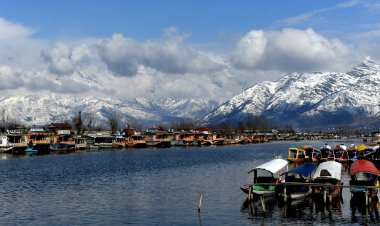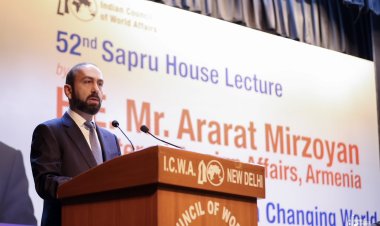Bangladesh’s Islamist surge: ISI’s new playbook targets Ahmadiyas after ISKCON and Hindus

Analysis
By Salah Uddin Shoaib Choudhury
Bangladesh is entering one of the most precarious phases in its modern political history. Since the Jihadist Coup last year - engineered through the convergence of US Deep State interests and the operational machinery of Pakistan’s Inter-Services Intelligence (ISI) - Dhaka’s political landscape has tilted sharply toward religious radicalism. Waves of anti-Hindu, anti-ISKCON, and anti-India agitation have now evolved into a dangerous new phase: a coordinated attempt to ignite anti-Ahmadiya sentiment across the country.
This shift is not accidental. It reflects a broader geopolitical contest in South Asia, where Pakistan’s military-intelligence establishment seeks to extend its ideological influence eastward, weaken India’s periphery, and turn Bangladesh into a pliable Islamist frontier. Within this context, the anti-Ahmadiya drive is not simply about religious bigotry - it is a strategic instrument, designed to reshape Bangladesh’s internal equilibrium and alter regional power dynamics.
ISI’s revival strategy: Bangladesh as the “Eastern Theatre”
For decades, the ISI has treated extremism not as a byproduct of governance failure, but as a calibrated tool of foreign policy. In Afghanistan, Kashmir, and parts of the Gulf, Pakistan’s security establishment has honed a doctrine that blends religious extremism with covert operations.
Bangladesh now sits at the crossroads of this revived strategy.
Following the 2024 power shift in Dhaka, Pakistan has found a permissive environment to expand its intelligence networks, activate sleeper groups, and encourage radical organizations to seize political and social space. The surge in anti-Hindu and anti-ISKCON violence was the first signal. The anti-Ahmadiya movement - historically a hallmark of Pakistan’s domestic politics - has now emerged as the second phase of this playbook.
The ISI understands that by targeting Hindus, Ahmadis, and liberal Muslims simultaneously, it can fracture Bangladesh’s social cohesion and push the country toward a Pakistan-style religious homogenization. This transformation, if successful, would dangerously alter the region’s strategic architecture.
Yunus, power ambitions, and strategic leverage
Although Muhammad Yunus publicly insists, he will hold elections in February and transfer power to an elected government, his repeated statements about remaining in power “5, 10, even 50 years” - in his interview with Mehdi Hasan - suggest a more authoritarian inclination. This is not lost on Pakistan.
For Islamabad’s military establishment, Yunus is perceived as the ideal interlocutor:
· Politically inexperienced,
· Structurally dependent on Western support,
· Surrounded by advisors aligned with globalist networks, and
· Lacking a mass political base - making him vulnerable to foreign influence.
ISI’s strategists also believe Yunus can help Pakistan rehabilitate its influence in Bangladesh - an ambition rooted in the trauma of 1971. Pakistan’s policymakers, including Army Chief General Asim Munir, quietly view the current situation as an “opening” to reverse decades of strategic retreat.
Washington’s blind spot
While the US was instrumental in enabling the political transition that brought Yunus to the helm, Washington itself does not have an ideological interest in persecuting Hindus, ISKCON followers, or Ahmadiyas. Rather, its primary concerns lie in countering China, maintaining maritime access, and preserving leverage over Dhaka’s political class.
However, America’s policy miscalculation lies in inadvertently empowering Pakistan as a regional subcontractor. As Tulsi Gabbard - the Director of National Intelligence - acknowledged at the IISS Manama Dialogue, Washington now recognizes the dangers of past regime-change interventions. Yet this does not undo the vacuum created in Bangladesh.
Into that vacuum stepped the ISI.
And the consequences are now unfolding across Bangladesh’s religious, political, and social spheres.
The return of Anti-Ahmadiya agitation in Bangladesh
Bangladesh last saw organized anti-Ahmadiya violence in 1998–1999, when an Ahmadiya mosque in Khulna was attacked. BBC reporting at the time detailed how extremists viewed the Ahmadiya belief in Mirza Ghulam Ahmad as a direct challenge to orthodox doctrine - especially regarding the belief that Jesus survived crucifixion and died in Kashmir.
Although sporadic attempts continued, the movement remained largely dormant after 2005.
Now, nearly two decades later, it has forcefully resurfaced.
The November convergence: ISI’s transnational footprint
In early November, a high-profile Islamist gathering in Dhaka signaled a turning point. Maulana Fazlur Rehman, chief of Jamiat-e-Ulama-e-Islam Pakistan and a known ally of Pakistan’s military establishment, arrived in Bangladesh to attend the “International Fida-e Millat Conference 2025” at Suhrawardi Udyan.
Joining him were Islamist leaders from India, Turkey, Nepal, the UK, and Europe, along with senior clerics from madrassas and religious institutions across Bangladesh. This transnational clerical convergence mirrors the ISI’s past tactics in Afghanistan and Kashmir - unifying clergy networks to create ideological momentum.
Demand: Declare Ahmadiyas non-Muslim
During the conference, Mohiuddin Rabbani, Secretary General of International Majlis-e-Tahaffuz-e-Khatme Nabuwat Bangladesh, issued a stark warning:
“If the Qadianis are not declared non-Muslim, tougher programs will be announced”.
Speakers demanded that Ahmadis be barred from mosques, their literature banned, and their community stripped of legal protections. The language, tone, and demands were nearly identical to Pakistan’s 1974 anti-Ahmadi ordinance under Zulfiqar Ali Bhutto.
BNP, Jamaat, and political legitimization
What makes the situation more alarming is the participation of mainstream political forces. BNP leader Salahuddin Ahmed declared that if BNP returns to power, it would “restore faith in Allah” and pursue anti-Ahmadi legislation in parliament. Jamaat-e-Islami, Islami Andolon Bangladesh, Bangladesh Khelafat Majlis, and Hefazat-e-Islam all participated in the mobilization.
This aligns perfectly with ISI objectives: creating a unified Islamist bloc capable of exerting legislative and street pressure.
The September warning
In September, Rabbani had already signaled the plan, stating that Ahmadis were “destroying the faith of Bangladesh’s Muslims”. Shortly thereafter, an Ahmadi community member told Indian media: “There is a tilt towards a Pakistani mindset of persecuting religious minorities”.
The timing of these events - coinciding with political uncertainty, foreign influence, and internal fragmentation - suggests a highly coordinated strategy.
Pakistan’s export of anti-Ahmadiya ideology
In Pakistan, Ahmadis have long been declared “wajibul qatal” - a term implying that killing them is religiously justified. This ideology has been exported to diaspora networks worldwide. In 2016, leaflets threatening Ahmadis with death were discovered at Stockwell Green Mosque in London. Al Jazeera estimates that 600,000–700,000 Ahmadis live in Pakistan, with millions worldwide - many in regions vulnerable to Islamist mobilization.
Bangladesh’s current trajectory resembles the initial stages of Pakistan’s anti-Ahmadi escalation.
If left unchecked, it could become entrenched as a permanent, politically profitable issue.
Implications for India and the region
The resurgence of Pakistan’s ideological imprint in Bangladesh holds major geopolitical consequences:
1. India’s eastern vulnerability
A radicalized Bangladesh would create three major security challenges for India:
· A jihadist corridor spanning Cox’s Bazar to Assam
· Increased cross-border trafficking and terror financing
· Strategic pressure from ISI-linked networks along the Siliguri Corridor.
2. regional Islamist bloc formation
The November Dhaka conference brought together Islamist leaders from Pakistan, India, Nepal, and Turkey - suggesting an attempt to construct a cross-border ideological alliance.
3. Destabilization of maritime routes
Bangladesh’s proximity to the Bay of Bengal makes it a critical node for maritime security. Radicalization risks creating safe havens for groups with transnational reach.
4. China’s strategic dilemma
While Pakistan benefits from instability, China - Bangladesh’s economic partner - may view growing extremism as a threat to its infrastructure investments and trade corridors.
Bangladesh is on the edge of an ideological reengineering
The revival of anti-Ahmadiya extremism in Bangladesh signals a profound ideological reengineering underway. It is not merely a religious dispute - it is a geopolitical project involving Pakistan’s ISI, transnational Islamist networks, and complicit political actors within Bangladesh.
Bangladesh’s future direction hinges on whether its moderate majority, political leadership, civil society, and security apparatus can resist this orchestrated slide toward a Pakistan-style theocratic order.
If this malignant trend continues unchallenged, Bangladesh risks transforming into:
· a terror-transit hub,
· a narco-jihadist corridor, and
· a destabilizing force on India’s eastern flank.
The persecution of Ahmadiyas is a warning sign. What follows may be far more consequential - not only for Bangladesh, but for the entire region’s security, stability, and social fabric.
Disclaimer: This paper is the author's individual scholastic contribution and does not necessarily reflect the organization's viewpoint.
Salah Uddin Shoaib Choudhury is an award-winning journalist, writer, and Editor of the newspaper Blitz. He specializes in counterterrorism and regional geopolitics.
























